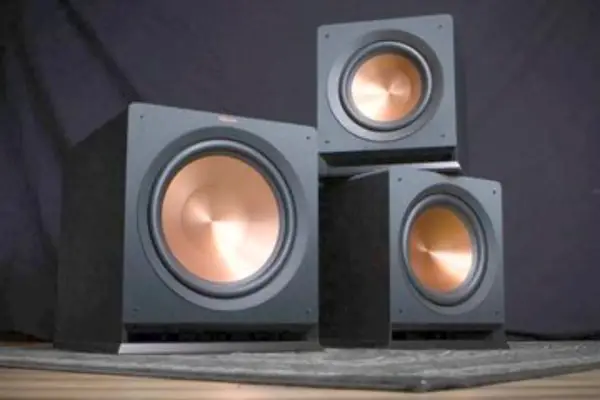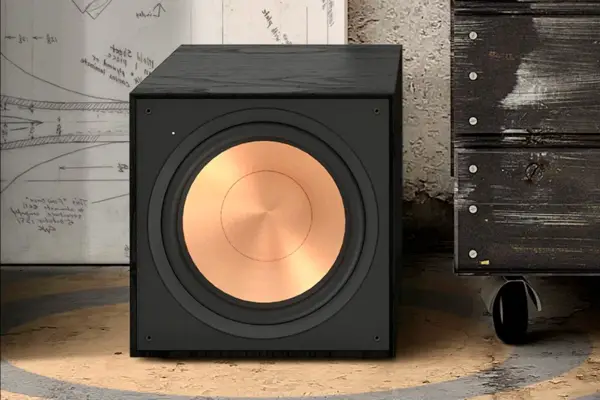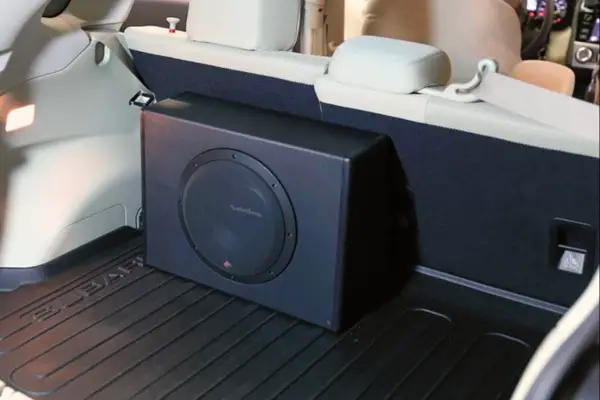What is a Powered Subwoofer?
The role of the subwoofer in enhancing the audio experience, whether in a home theater, vehicle or professional music production, is undeniable. While subwoofers come in various forms, this article will delve into the specifics of what is a powered subwoofer – a complex yet highly efficient piece of audio equipment.
A powered subwoofer, AKA an active subwoofer, is a specialized loudspeaker that reproduces low-pitched audio frequencies, commonly referred to as bass. Unlike its counterpart, the passive subwoofer, a powered subwoofer features a built-in amplifier.
This inclusion eliminates the need for an external amplifier, which not only makes the setup process simpler but also optimizes the subwoofer’s performance by matching the amplifier’s characteristics with the subwoofer’s capabilities.
Through this article, we aim to deepen the understanding of what powered subwoofers are – their design, workings, uses, and benefits. Additionally, we’ll guide you on the essential factors to consider when purchasing one and share maintenance tips to ensure its longevity.
Evolution of Subwoofers
Tracing the History of Subwoofers
Subwoofers, as we know them today, have evolved considerably since their inception. The first subwoofers were developed in the 1960s as a part of cinema sound systems, aiming to reproduce the low-frequency sounds and ‘rumble’ effects in movies. However, it wasn’t until the 1970s that subwoofers started making their way into home audio systems.
>>Powered Subwoofers for Cars<<
The Inception of Powered Subwoofers
The concept of integrating an amplifier within the subwoofer, hence creating a ‘powered’ or ‘active’ subwoofer, came much later. This innovation was driven by the need for ease of use and system efficiency. It resolved the issue of matching an external amplifier’s power output with the subwoofer’s power handling capabilities, a common challenge faced with passive subwoofers.

The Technological Advancements in Subwoofers
With advancements in technology, powered subwoofers have seen a significant improvement in their performance. Modern designs ensure better control over the cone’s movement, resulting in precise sound reproduction.
Further, the inclusion of features like adjustable crossover frequency, phase control, and room correction software in some models has allowed users to tailor the bass response as per their preference or room acoustics.
Understanding Powered Subwoofers
The Mechanics behind Powered Subwoofers
To comprehend what a powered subwoofer is, it’s crucial to understand the mechanics behind it. In essence, a powered subwoofer is a speaker specifically designed to reproduce low-frequency sound or bass, with a built-in amplifier.
The built-in amplifier is critical as it not only provides the necessary power for the subwoofer to function but also eliminates the need for an external power source.
Difference between Powered and Passive Subwoofers
When you’re trying to figure out what a powered subwoofer is, one of the easiest ways is to contrast it with a passive subwoofer. While both types have the common goal of producing bass, a passive subwoofer requires an external amplifier to operate.
On the other hand, a powered subwoofer has an integrated amplifier, making it more compact and user-friendly, while offering superior performance optimization.
Benefits of Using a Powered Subwoofer
The inclusion of an inbuilt amplifier in a powered subwoofer brings several benefits. It simplifies the setup process, reduces clutter from extra cables and equipment, and ensures optimal performance by perfectly matching the amplifier to the subwoofer’s specifications.
And, modern powered subwoofers often come with features like adjustable crossover frequency and phase control, enabling users to customize the bass response to their liking.

Components of a Powered Subwoofer
Parts of a Powered Subwoofer
A powered subwoofer consists of three primary components: the driver, the amplifier, and the enclosure.
The driver, or speaker cone, moves air to produce sound, with larger drivers typically capable of delivering deeper bass.
The amplifier provides the power needed for the driver to function, and its integration within the subwoofer unit distinguishes powered subwoofers from passive ones.
Lastly, the enclosure, or cabinet, houses these components and significantly influences the subwoofer’s sound quality.
How These Components Work Together to Produce Sound
In a powered subwoofer, the integrated amplifier sends power to the driver, causing it to vibrate and move air within the enclosure. These vibrations are then pushed out of the enclosure, creating the low-frequency sounds we perceive as bass.
The whole process is optimized as the amplifier is specifically designed for the driver, ensuring maximum efficiency and performance.
The Role of Amplification in Powered Subwoofers:
Amplification plays a crucial role in a powered subwoofer. It not only eliminates the need for an external amplifier but also optimizes the subwoofer’s performance by providing the exact amount of power required by the driver.
This perfect match between the amplifier and the driver, achievable in powered subwoofers, results in a highly efficient and effective system capable of producing deep, impactful bass.
Passive vs Active (Powered) Subwoofers
In Home Theaters
When considering home theaters, the choice between passive and active subs largely depends on individual needs and preferences.
Powered subwoofers are often the go-to choice due to their simplified setup and built-in amplification. They offer a plug-and-play convenience that makes them ideal for most home users.
The integrated amplifier is tailored to the driver, ensuring optimized performance and reducing the risk of damage due to mismatched components.
Additionally, powered subwoofers often feature adjustable settings allowing users to fine-tune the bass output to match their room acoustics and personal preference.
On the other hand, passive subwoofers offer a higher degree of flexibility. They require an external amplifier, which can be beneficial for those seeking to customize their sound system extensively. And, this also means a more complex setup and the added responsibility of matching the amplifier to the subwoofer’s specifications.

In Vehicles
The choice between passive and powered subwoofers in vehicles often comes down to space constraints and power requirements.
Powered subwoofers are generally more compact, making them a popular choice for vehicles with limited space. They provide a self-contained solution, eliminating the need for an additional amplifier and making installation easier.
However, they might require a direct connection to the vehicle’s battery to meet their power needs.
Passive subwoofers, needing an external amplifier, can be bulkier. However, they can deliver more powerful bass if paired with a high-output amplifier. Additionally, some car audio enthusiasts prefer them for the flexibility they offer in terms of system customization.
Keep in mind that installing a passive subwoofer in a vehicle usually involves more wiring and a more complex setup process.
What is a Passive Subwoofer?
What is a powered subwoofer? In conclusion, a powered subwoofer is a specialized type of loudspeaker engineered to reproduce low-frequency sounds or bass with an integrated amplifier.
This unique design simplifies the setup, reduces the need for additional equipment, and ensures optimized performance by perfectly pairing the amplifier and subwoofer’s capabilities.

I am a passionate and skilled car audio enthusiast with 15 years of experience in the industry. My journey started when I replaced my first set of factory car speakers, sparking a deep love for high-quality sound. Since then, I have worked as a representative for renowned brands like Kenwood and Alpine.
With a background in both retail and distribution, I have developed a comprehensive understanding of the car audio market. Currently a certified (MECP) installer in the Mobile Electronics industry, my expertise lies in delivering top-notch audio installations. My knowledge, coupled with my genuine passion, makes me the go-to professional for all car audio needs.


